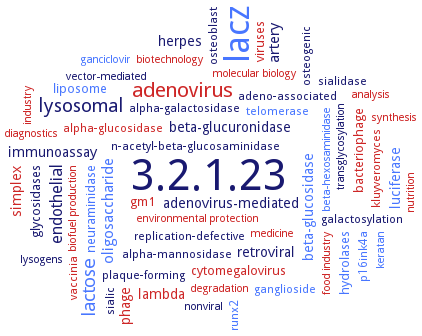3.2.1.23: beta-galactosidase
This is an abbreviated version!
For detailed information about beta-galactosidase, go to the full flat file.

Word Map on EC 3.2.1.23 
-
3.2.1.23
-
lacz
-
adenovirus
-
lysosomal
-
lactose
-
endothelial
-
oligosaccharide
-
artery
-
phage
-
adenovirus-mediated
-
beta-glucosidase
-
immunoassay
-
retroviral
-
beta-glucuronidase
-
herpes
-
lambda
-
simplex
-
luciferase
-
cytomegalovirus
-
neuraminidase
-
viruses
-
hydrolases
-
bacteriophage
-
glycosidases
-
gm1
-
liposome
-
ganglioside
-
p16ink4a
-
alpha-galactosidase
-
alpha-mannosidase
-
osteogenic
-
vaccinia
-
adeno-associated
-
replication-defective
-
n-acetyl-beta-glucosaminidase
-
runx2
-
sialidase
-
alpha-glucosidase
-
sialic
-
galactosylation
-
plaque-forming
-
osteoblast
-
kluyveromyces
-
telomerase
-
analysis
-
degradation
-
diagnostics
-
lysogens
-
beta-hexosaminidase
-
keratan
-
vector-mediated
-
biotechnology
-
molecular biology
-
synthesis
-
environmental protection
-
ganciclovir
-
nutrition
-
transglycosylation
-
medicine
-
industry
-
nonviral
-
food industry
-
biofuel production
- 3.2.1.23
- lacz
- adenovirus
- lysosomal
- lactose
- endothelial
- oligosaccharide
- artery
- phage
-
adenovirus-mediated
- beta-glucosidase
-
immunoassay
-
retroviral
- beta-glucuronidase
-
herpes
- lambda
- simplex
- luciferase
- cytomegalovirus
- neuraminidase
- viruses
- hydrolases
- bacteriophage
- glycosidases
- gm1
- liposome
- ganglioside
- p16ink4a
- alpha-galactosidase
- alpha-mannosidase
-
osteogenic
- vaccinia
-
adeno-associated
-
replication-defective
- n-acetyl-beta-glucosaminidase
- runx2
- sialidase
- alpha-glucosidase
-
sialic
-
galactosylation
-
plaque-forming
-
osteoblast
- kluyveromyces
- telomerase
- analysis
- degradation
- diagnostics
-
lysogens
- beta-hexosaminidase
- keratan
-
vector-mediated
- biotechnology
- molecular biology
- synthesis
- environmental protection
- ganciclovir
- nutrition
-
transglycosylation
- medicine
- industry
-
nonviral
- food industry
- biofuel production
Reaction
Synonyms
Aabeta-gal, Acid beta-galactosidase, B-GAL, BbgI, BbgII, BbgIII, BbgIV, beta galactosidase, beta-D-galactohydrolase, beta-D-galactosidase, beta-D-galactoside galactohydrolase, beta-D-glactanase, beta-D-lactosidase, beta-gal, beta-Gal 1, beta-Gal 2, beta-Gal II, beta-galactosidase, beta-galactosidase I, beta-galactosidase II, beta-galactosidase III, beta-galactosidase IV, beta-galase, beta-lactosidase, betagal, betaGly4, betaGS, BGA, BgaB, BgaBM, bgaD, BgaH, BGAL, BGAL1, BGAL10, BGAL11, BGAL12, BGAL13, BGAL14, BGAL15, BGAL16, BGAL17, BGAL2, BGAL3, BGAL4, BGAL5, BGAL6, BGAL7, BGAL8, BGAL9, BgalA, BgAP, BgaS, BgaX, BGL1, BglAp, BGT I, BGT II, cold-active beta-galactosidase, CTP-beta-gal, driselase, EABase, endo-beta-galactosidase, Exo-(1-->4)-beta-D-galactanase, exo-beta-(1->3)-D-galactanase, Gal-2, Gal-5, GAL1, Gal2, Gal3, Gal4, GALA, galactanase, galactosidase, galactosidase, beta, GALB, gherkin lactase, H-BgaS, hcbetagal, Hlac_2868, Hydrolact, LacA, LACS, lactase, lactase phlorizin hydrolase, lactosylceramidase II, Lactozym, Lactozym 3000L, LPH, Maxilact, Maxilact-L/2000, MeBglD2, More, ONPGase, Oryzatym, p-nitrophenyl beta-galactosidase, PF1208, PRGH1, S 2107, SA-beta-GAL, SA-betagal, senescence-associated beta-galactosidase, SPD_0065 protein, SR12 protein, Ss beta-gal, SSO3019, SSU0587, Sumiklat, Trilactase, XC1214, XG-specific beta-galactosidase, YesZ, YH4502, ZD410


 results (
results ( results (
results ( top
top





